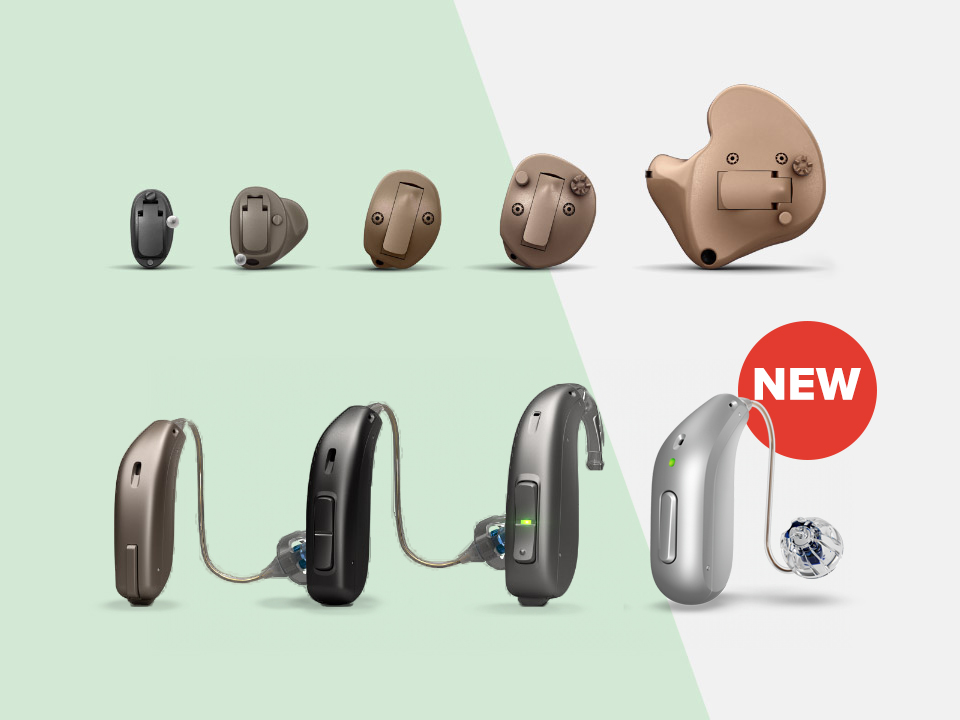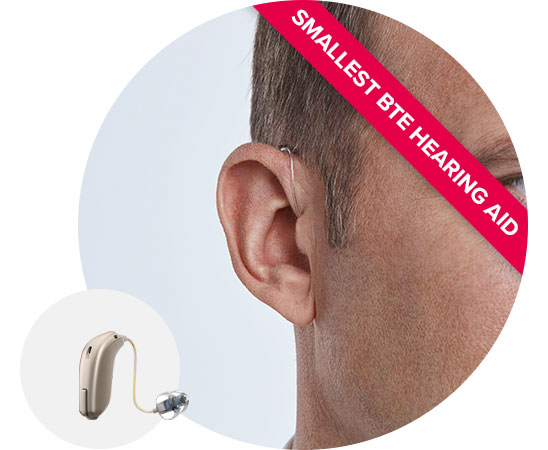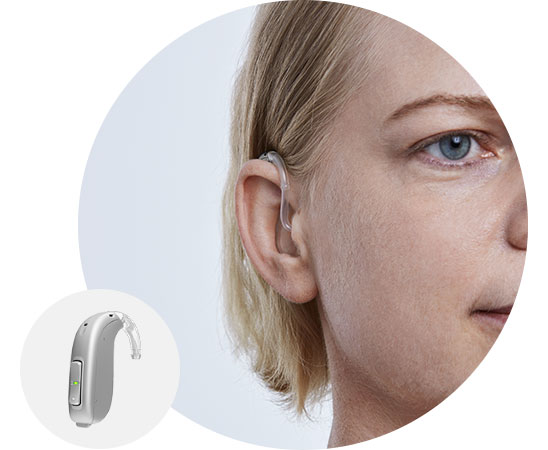Behind the ear hearing aids

What are behind the ear hearing aids?
Behind the ear hearing aids have a design that allows the main body of the hearing aid to sit behind the ear. A clear, discreet tube is then connected to an ear mold or dome and placed inside the ear canal.
Hearing aids behind the ear are the most widely used types of hearing aids on the market today. Recently, they have become smaller (the same is true for in-the-ear hearing aids), more adaptable, and much more powerful.









Find the Right Hearing Aid for Your Needs
Take one minute to find out which hearing aid model suits your preferences.
Your result
Based on your answers the following hearing aid types would suit your needs:
- miniRITE R
*The result of the test may only be used for guidance and is not meant to replace a more accurate measurement of your hearing abilities and needs by one of our hearing care professional.
Would you like to visit us for your free trial?
Book a FREE trialYour result
Based on your answers the following hearing aid types would suit your needs:
- miniRITE R
*The result of the test may only be used for guidance and is not meant to replace a more accurate measurement of your hearing abilities and needs by one of our hearing care professional.
Would you like to visit us for your free trial?
Book a FREE trialYour result
Based on your answers the following hearing aid types would suit your needs:
- miniRITE
- BTE Plus/Ultra Power
- In-the-canal (ITC)
*The result of the test may only be used for guidance and is not meant to replace a more accurate measurement of your hearing abilities and needs by one of our hearing care professional.
Would you like to visit us for your free trial?
Book a FREE trialYour result
Based on your answers the following hearing aid types would suit your needs:
- miniRITE
- BTE Plus/Ultra Power
*The result of the test may only be used for guidance and is not meant to replace a more accurate measurement of your hearing abilities and needs by one of our hearing care professional.
Would you like to visit us for your free trial?
Book a FREE trialYour result
Based on your answers the following hearing aid types would suit your needs:
- miniRITE R
*The result of the test may only be used for guidance and is not meant to replace a more accurate measurement of your hearing abilities and needs by one of our hearing care professional.
Would you like to visit us for your free trial?
Book a FREE trialYour result
Based on your answers the following hearing aid types would suit your needs:
- miniRITE R
*The result of the test may only be used for guidance and is not meant to replace a more accurate measurement of your hearing abilities and needs by one of our hearing care professional.
Would you like to visit us for your free trial?
Book a FREE trialYour result
Based on your answers the following hearing aid types would suit your needs:
- miniRITE
- Invisible-in-the-canal (IIC)
- Completely-in-the-canal (CIC)
- In-the-canal (ITC))
*The result of the test may only be used for guidance and is not meant to replace a more accurate measurement of your hearing abilities and needs by one of our hearing care professional.
Would you like to visit us for your free trial?
Book a FREE trialYour result
Based on your answers the following hearing aid types would suit your needs:
- Halfshell/full shell
- miniRITE
*The result of the test may only be used for guidance and is not meant to replace a more accurate measurement of your hearing abilities and needs by one of our hearing care professional.
Would you like to visit us for your free trial?
Book a FREE trialBehind-the-ear hearing aid styles
Learn about and compare the different styles
Receiver-in-the-ear hearing aids
The RITE and the smaller miniRITE hearing aid is placed discreetly behind the ear and is connected by a thin wire which places the speaker or receiver inside the opening of the ear or ear canal.
- Suitable for most types of hearing loss
- Smaller and less noticeable than traditional BTE hearing aids
- Rechargeable battery options available
- Able to connect to smart devices via Bluetooth®
- Often connected to a small dome for ventilation

Behind-the-ear (BTE) hearing aids
A clear, thin tube connects the main body of the hearing aid (nestled behind the ear) to an earmold or dome that fits inside the ear canal. The following features make BTE hearing aids a versatile option:
- Able to connect to smart devices via Bluetooth®
- Suitable for all types of hearing loss
- Suitable for all ear and ear canal sizes
- Able to accommodate high-tech features (due to larger size)
- Telecoil, volume and program controls are easy to manipulate
- Larger battery size provides more power

Open-fit for behind-the-ear hearing aids
Open-fit (also called Corda miniFit) is a thin tube mounted on behind-the-ear hearing aids with a dome or micro mold as an earpiece.
An ultra-thin, discreet solution, delivering all the benefits of open fittings:
- Keeps the ear canal open so that sound can enter more naturally
- Filters out background noises
- Includes a more powerful battery than most behind-the-ear hearing aids
Pros and cons of hearing aids behind the ear
Learn about what to expect from hearing aids behind the ear
Pros |
Cons |
| Comfortable Because they do not sit deep inside the ear canal, some users find them more comfortable. |
Might be more visible Since BTE hearing aids are tucked behind the ear, they might be more noticeable than smaller in-the-ear hearing aids. |
| Rechargeable batteries They are available with both disposable and rechargeable battery options |
More likely to pick up wind noise: The behind-the-ear placement means that these devices are more likely to pick up wind noise, but recent technology provides solutions for counteracting the issue. |
| Bluetooth® connectivity They can connect wirelessly to smart devices with Bluetooth® |
|
| Suitable for severe hearing loss They can cater to more severe hearing loss levels than some other hearing aid types |
|
| Longer battery life They include larger batteries, allowing for a longer battery life |
|
| Easier to keep clean Since only the ear mold or dome comes in direct contact with the ear canal, they are less vulnerable to moisture and wax build-up |
|
| Fewer issues with feedback This benefit is achieved by the microphone and receiver being placed farther away from each other than in some ITE hearing aids |
|
| More open-fitting The thin tube that sits in the ear canal provides ample air ventilation |



